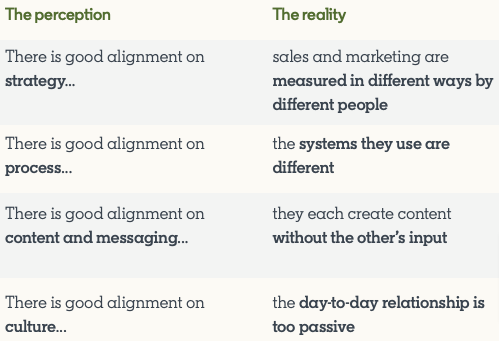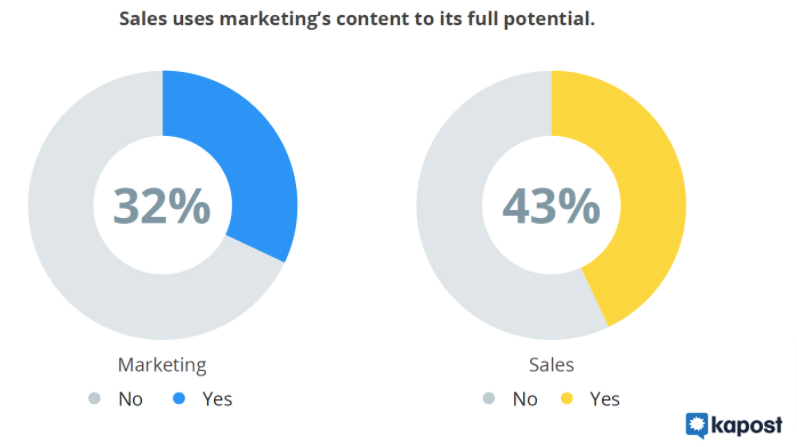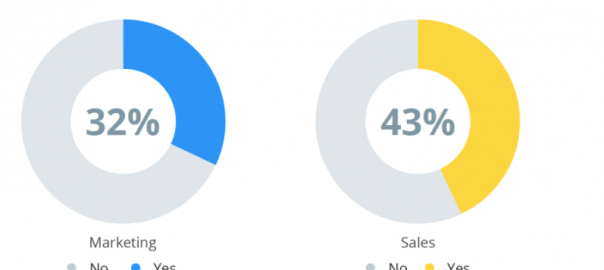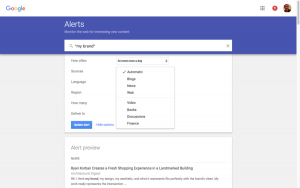Effective collaboration is an objectively “good thing” for any business function. But it arguably makes the biggest difference in sales and marketing.
According to LinkedIn research, almost nine in 10 sales and marketing leaders say closer alignment between the two functions is the number one opportunity for improving business performance today.
However, wanting sales and marketing to work more closely together is a very different thing to actually achieving it.
In reality, LinkedIn found nine-tenths of smarketing leaders also say the two departments are fundamentally misaligned on strategy, process, content, and culture. Clearly, that presents a major barrier to collaboration.

- Image Source
The benefits to closing the gap between sales and marketing are tangible, though, so it’s worth investing time and money to make it happen. Here are six of the biggest benefits you can enjoy:
1. Generate More (& Better) Leads
Lead volume and quality are major pain points for sales teams, with 23% of salespeople naming “better quality leads” as their top requirement from the marketing team, and 15% citing “more leads”.
That’s hardly surprising.
Without a constant stream of leads, sales teams will always struggle to hit their targets. What’s more, they want those leads to be well qualified, because they don’t want to waste their time and energy speaking to people who were just never going to convert.
So it’s equally unsurprising that lead volume and quality are often the biggest cause of sales and marketing friction.
Sales reps claim the leads they’re given by marketing are little more than names in a CRM. They’re poorly qualified and just aren’t interested.
Marketers respond by arguing that sales aren’t making effective use of those leads. They’re rushing to close the deal rather than taking the time to nurture them.
The truth typically lies somewhere between those two extremes, but rather than collaborating to help things run more smoothly, the two functions often end up pointing fingers and denying responsibility.
It doesn’t need to be like that. Aligned sales and marketing teams that communicate regularly can share information about what works and what doesn’t. That means marketing can fine-tune its approach to focus on targeting high-converting personas with messaging that truly resonates.
That way, everybody wins.
2. Build More Accurate Buyer Personas
While sales and marketing teams might spend a lot of time squabbling over who has the biggest impact on bringing in new business, both ultimately play a key role in nurturing leads and closing deals.
When they’re on the same page, utilizing their specific strengths and skills to achieve common goals, the results are invariably better. On the other hand, when sales and marketing functions aren’t communicating effectively, processes break down and performance drops.
Buyer personas are often one of the first things to suffer when smarketing teams are misaligned. You might think you’re targeting one audience, but your personas might be missing the mark.
This is all about shared ownership. When sales and marketing feel they have an equal part to play in creating and honing personas, they’ll work together to ensure those personas are as accurate as possible.
Sales can provide clear, helpful feedback when leads don’t match up with the audience you’re striving to reach. In turn, this allows marketing to re-examine buyer personas and update their targeting as necessary.
This isn’t just good news for your business; it’s great for your prospects too.
Accurate personas mean a stronger understanding of the pain points your leads are facing and the goals they’re looking to achieve, which makes for a much smoother and more engaging journey through the sales funnel. It’s no coincidence that 70% of sales and marketing professionals believe closer collaboration results in a more positive buying experience.
3. Make Smarter Use of Resources
According to the LinkedIn study referenced earlier, 93% of sales and marketing professionals identify a host of barriers to building closer cultural alignment between the two teams. Specifically:
- Sales and marketing don’t feel they play an active role in one another’s planning processes
- Communication between the teams isn’t as concise as it should be
- A degree of antagonism exists between the two functions
Clearly, where those challenges exist, neither function will be performing as well as it could.
For instance, when effective communication – whether in person, via chat and email, or through virtual meetings – doesn’t exist, marketing might push messaging and create collateral for products the sales team isn’t currently promoting or offers that are no longer live.
This is a big problem for sales. Not only are they having to cope without quality marketing materials, but they’re also having to repeatedly explain the confusion to prospects who want to sign up for a product or promotion that’s unavailable to them.
Marketing teams aren’t doing this on purpose; they want to produce high-quality leads and useful assets. But to do that, they need to understand exactly what they should be promoting (and what they should be ignoring) at any given time.
When that happens, both teams are happy and the sales pipeline runs smoothly, which means you’re making the best possible use of your smarketing resources.
4. Create More Impactful Marketing Materials
Marketing teams don’t create content for the sake of it. They do it to achieve specific goals.
Ultimately, whatever industry they’re in and whatever audience they’re targeting, those goals will almost always relate to one thing – earning their company money.
Fashion brands want content that reaches new audiences and compels them to buy a new jacket or pair of sunglasses. SaaS sales teams want content that helps them reach new leads and guide them through the sales funnel.
So it’s a big concern that just 32% of marketers and 43% of salespeople believe the sales function is making full and effective use of marketing content.

- Image Source
This (probably) isn’t because marketing teams aren’t up to the task, or because sales teams don’t know what to do with the content they’re given. More likely it’s because the two teams just aren’t working closely together.
Your sales team likely hears a lot of the same questions and objections when they speak to leads. Things like:
- Why should I choose you over your competitor?
- Why is your product so expensive? Your competitor is much cheaper
- Why do I need to pay for all these features? I only need one of them
When these questions and objections are communicated to marketing, it’s an easy “win”, because it allows them to create highly targeted and informative content that adds real value for your salespeople and their prospects.
From blog posts to ebooks, sales can use these assets to anticipate and answer all those frequently asked questions before they arise. In turn, that smoothes the buyer journey and helps leads make more informed decisions.
5. Develop a Clearer, Smarter Strategy
Companies with closely aligned sales and marketing teams tend to share a lot of common traits. For instance, they’re typically highly strategic and focused on achieving long-term value.
By actively working toward the goal of improving collaboration between sales and marketing, these companies are able to elevate the performance of both teams.
Give the two functions an accurate picture of what success looks like – not just now, but three or five years down the line – and they’ll be able to build a clear and intelligent strategy to hit all your key numbers.
In turn, they can use that overarching roadmap to develop specific actions for each individual team. Marketing might commit to creating and running a new lead generation campaign every quarter, while sales might pledge to run regular feedback meetings to share insights on what’s working well (and what isn’t).
Together, they can leverage this alignment to build ever-stronger and more effective campaigns, which means your organization is more likely to hit its big-picture targets.
6. Map the Buyer Journey More Effectively
Many sales and marketing teams fall down because they fail to consider how the sales funnels they’ve crafted actually work for the most important people – your prospective customers.
This is a crucial piece of the sales and marketing puzzle for any business, but it becomes even more significant for organizations adopting account-based marketing. If you don’t have an accurate idea of your buyers’ pains and objectives at each stage of the sales process, how are you going to achieve the kind of laser-focused personalization required for an account-based approach?
All too often, things break down at the arbitrary speed bump in the sales funnel that comes when marketing hands a lead over to sales.
By this point, a prospect should already have qualified themselves to at least some extent. By downloading a specific piece of content or registering for a specific webinar, they’ve signaled their interest in a specific topic and signaled their need for a certain type of solution.
So the last thing they want is to retread old ground by answering a whole other batch of qualifying questions.
When the buyer journey is mapped effectively, these barriers are removed because sales and marketing are able to take a more holistic approach, which results in a more streamlined path to purchase.
Digital & Social Articles on Business 2 Community
(62)
Report Post








